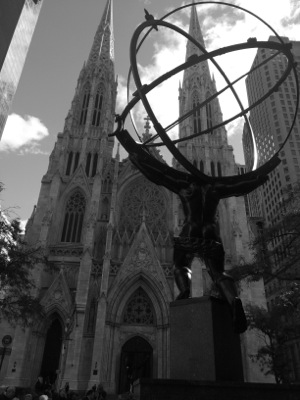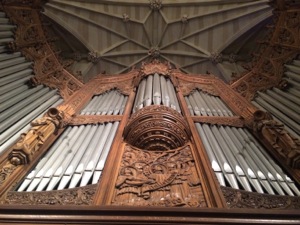
 HERE IS the old story of the blind men and the elephant—each with a different perspective and experience—each coming up with their own understanding or interpretation of their interaction—and none with a complete and accurate picture.
HERE IS the old story of the blind men and the elephant—each with a different perspective and experience—each coming up with their own understanding or interpretation of their interaction—and none with a complete and accurate picture.
With that story in mind, I understand that a single point of view is rarely the entire truth. On the other hand, an outside observer is occasionally helpful to draw attention to certain worthy characteristics.
I recently had the opportunity to perform in concert at St. Patrick’s Cathedral in New York City, certainly one of the most well known Roman Catholic landmarks in the United States. As a native New Yorker, I have taken it for granted as a part of the landscape.
However, after a few days of preparation (on the Kilgen Organs of more than 9,000 pipes, 206 stops, 150 ranks and 10 divisions), I was able to observe much of daily life at the Cathedral. This view—from the choir loft and behind the scenes—left me with some enduring impressions.
DISADVANTAGE INTO ADVANTAGE
Teeming with tourists, quiet refuge from the city may be hard to come by at St. Patrick’s Cathedral. Furthermore, its vast size, scale, and security needs pose myriad liturgical challenges.
Located on Fifth Avenue in Midtown Manhattan near Rockefeller Center, NBC Studios, Broadway, Times Square, etc., St. Patrick’s enjoys unprecedented foot traffic. As such, those who walk through its doors are from all walks of life—Catholics, non-Catholics, believers and non-believers. It is similar perhaps to cathedrals in Europe that in the public mind it is more of a tourist destination rather than a place of prayer.
Registering the organ in the afternoons during the height of tourist activity, magnified by unusually beautiful weather, was at times a challenge. This holy edifice could get quite noisy!
INSTEAD OF HIDING FROM THE DISTRACTION of tourists and tucking their seven daily Masses (five with music) in a secluded chapel, the celebration of the Eucharistic is boldly held in the main sanctuary amid sightseers and faithful alike.
Confession is widely available including after each of the morning daily Masses.
Furthermore, there is daily Exposition and Adoration of the Blessed Sacrament from 1pm-6pm in the Lady Chapel. Tourists cannot escape hearing O Salutaris Hostia.
Attending Mass before and sometimes after practice, I found it to be quite reverent regardless of how many were not there for the Eucharistic celebration. It was also refreshing to sing the Missa de Angelis for the Ordinary as well as the Gregorian Mysterium fidei at typical daily Masses.
EVANGELIZATION
Amidst one of the most secular places in the world, St. Patrick’s Cathedral is unapologetically welcoming and unapologetically Roman Catholic. They open the doors wide to people of all faiths and backgrounds, allowing them the freedom to move about and explore this historic sacred space. But they will celebrate the Eucharist, Adore the Blessed Sacrament, and administer the sacraments out in the open for all to witness and experience—nearly every hour of every day. In doing so, St. Patrick’s Cathedral fulfills its unique charism.
Related article: • Reverent and welcoming parishes are not mutually exclusive.
All are welcome. But none can escape hearing the prayers, Gregorian Chant, the organ, the devotions. All who have been welcomed off the streets encounter the good example of the faithful. And they may very well encounter God who is at the heart of daily life within the Cathedral. They may discover divine refuge from a world that all too often pushes God aside.

MUSICAL, PASTORAL, & LITURGICAL EXCELLENCE
 N ADDITION I have enjoyed an up-close view of the cathedral musicians. Dr. Jennifer Pascual, Director of Music since 2003 (and host of “Sounds from the Spires” on SIRIUSXM 129 Radio, The Catholic Channel) is the same genuine human being off-air as she is on. Associate Director of Music, Daniel Brondel wins the award for providing the most helpful tips and tutorial for the largest and most complex instrument—all in the shortest amount of time. The mammoth Kilgen Organs are quite literally a city block apart—the Gallery Organ near Fifth Avenue and the Chancel Organ towards Madison Avenue. Most generous with practice time (significant because the Mass schedule allows little time for themselves), Daniel told me, “We want people to succeed.” Together with Assistant Director of Music and Organist Michael Hey, the three of them exude a working chemistry that should be envied by any faith community, great or small.
N ADDITION I have enjoyed an up-close view of the cathedral musicians. Dr. Jennifer Pascual, Director of Music since 2003 (and host of “Sounds from the Spires” on SIRIUSXM 129 Radio, The Catholic Channel) is the same genuine human being off-air as she is on. Associate Director of Music, Daniel Brondel wins the award for providing the most helpful tips and tutorial for the largest and most complex instrument—all in the shortest amount of time. The mammoth Kilgen Organs are quite literally a city block apart—the Gallery Organ near Fifth Avenue and the Chancel Organ towards Madison Avenue. Most generous with practice time (significant because the Mass schedule allows little time for themselves), Daniel told me, “We want people to succeed.” Together with Assistant Director of Music and Organist Michael Hey, the three of them exude a working chemistry that should be envied by any faith community, great or small.
In the midst of putting Roman Catholicism out in the open in New York City, Dr. Pascual and her associates are not only superlative musicians, they are teachers and shepherds at heart. They combine musical and liturgical excellence with an understanding of pastoral musicianship. This is not to be taken for granted.
Likewise, we must all strive for excellence: musically, pastorally, and liturgically. God deserves our best.
Soli Deo gloria

